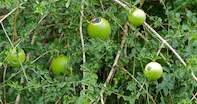Monkey orange (Strychnos spinosa) is also known as klapper, morapa, umKwakwa, Nsala, muramba and Umhlali. The small to medium-sized monkey orange tree grows singly between 1 and 9m high. It is thorny, with flaky peeling bark and glossy, almost round leaves.

Monkey orange prefers well-drained soils in the bushveld, riverine fringes, sand forest and coastal bush in the Eastern Cape, KwaZulu-Natal and Limpopo provinces. A related species the corky monkey orange (Strychnos cocculoides) has also been investigated to improve the income generation capacity of poor rural households.
Unlike in South Africa, the corky monkey orange is highly prioritised for domestication and cultivation in Malawi, Mozambique, Tanzania, Zambia and Zimbabwe. The grapefruit-sized monkey orange fruit has a sweet aroma with a sweet and sour taste and weighs over 0,45 kg. It is round with a thick, green woody skin, changing to brownish yellow as it ripens.
It has many large seeds in a yellow, strong-smelling pulp. Due to it being very tasty, monkey orange has considerable food value in rural communities. The fruits are eaten by both children and adults and collected early in the season (before it ripens) for storage. The ripe fruit keeps very well due to its hard shell. This makes it suitable for transporting long distances.
Around homesteads, monkey orange fruit is buried in sand to allow the fruit pulp to liquefy. The ripe fruit can be eaten raw or dried in the sun to make fruit rolls, jam and made into juice or wines. The fruit is high in vitamin C and the B vitamins, but monkey orange seeds are poisonous.
Wood is used for carving and timber while the bark, root or unripe fruit are used against snake bite due to the presence of strychnine. Crushed leaves can heal sores, while a strong tea made from the roots can help relieve cold symptoms.
Fresh leaves are pounded into a paste to treat sores and drained liquid from the crushed leaves can be sprayed as an natural insecticide against aphids and scale insects.
Leaves can be used to feed livestock and the dried fruit (after seeds have been discarded) are often carved and sold as curios or used as sounding boxes for musical instruments.
Monkey orange trees are difficult to grow from seeds, so the best way to propagate is by grafting. Grafting is when two parts of a plant are joined together. It is hardy, prefers to grow in the full sun but is sensitive to frost. It can make a good hedge or border plant.
Medical Disclaimer
Information is for educational and informational purposes only and may not be construed as medical advice. The information is not intended to replace medical advice or treatment offered by healthcare professionals.By Marinda Louw